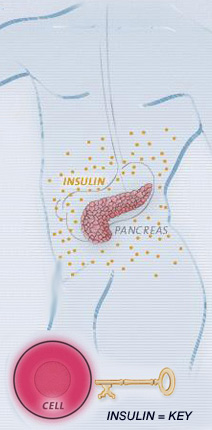What is diabetes?
@rashika77 (6)
Colombo, Sri Lanka
October 4, 2014 11:05pm CST
To answer that, you first need to understand the role of insulin in your body.When you eat, your body turns food into sugars, or glucose. At that point, your pancreas is supposed to release insulin.Insulin serves as a “key” to open your cells, to allow the glucose to enter -- and allow you to use the glucose for energy.But with diabetes, this system does not work.
Several major things can go wrong – causing the onset of diabetes. Type 1 and type 2 diabetes are the most common forms of the disease, but there are also other kinds, such as gestational diabetes, which occurs during pregnancy, as well as other forms.
Type 1 Diabetes
The more severe form of diabetes is type 1, or insulin-dependent diabetes. It’s sometimes called “juvenile” diabetes, because type 1 diabetes usually develops in children and teenagers, though it can develop at any age.
Immune System Attacks
With type 1 diabetes, the body’s immune system attacks part of its own pancreas. Scientists are not sure why. But the immune system mistakenly sees the insulin-producing cells in the pancreas as foreign, and destroys them. This attack is known as "autoimmune" disease.These cells – called “islets” (pronounced EYE-lets) – are the ones that sense glucose in the blood and, in response, produce the necessary amount of insulin to normalize blood sugars.Insulin serves as a “key” to open your cells, to allow the glucose to enter -- and allow you to use the glucose for energy.Without insulin, there is no “key.” So, the sugar stays -- and builds up-- in the blood. The result: the body’s cells starve from the lack of glucose.And, if left untreated, the high level of “blood sugar” can damage eyes, kidneys, nerves, and the heart, and can also lead to coma and death.
Insulin Therapy
So, a person with type 1 treats the disease by taking insulin injections.This outside source of insulin now serves as the “key” -- bringing glucose to the body’s cells.The challenge with this treatment is that it’s often not possible to know precisely how much insulin to take. The amount is based on many factors, including:
Food
Exercise
Stress
Emotions and general health
Balancing Act
These factors fluctuate greatly throughout every day. So, deciding on what dose of insulin to take is a complicated balancing act.If you take too much, then your body burns too much glucose -- and your blood sugar can drop to a dangerously low level. This is a condition called hypoglycemia, which, if untreated, can be potentially life-threatening.If you take too little insulin, your body can again be starved of the energy it needs, and your blood sugar can rise to a dangerously high level -- a condition called hyperglycemia. This also increases the chance of long-term complications.
Type 2 Diabetes
The most common form of diabetes is called type 2, or non-insulin dependent diabetes.This is also called “adult onset” diabetes, since it typically develops after age 35. However, a growing number of younger people are now developing type 2 diabetes.People with type 2 are able to produce some of their own insulin. Often, it’s not enough. And sometimes, the insulin will try to serve as the “key” to open the body’s cells, to allow the glucose to enter. But the key won’t work. The cells won’t open. This is called insulin resistance.Often, type 2 is tied to people who are overweight, with a sedentary lifestyle.
Treatment focuses on diet and exercise. If blood sugar levels are still high, oral medications are used to help the body use its own insulin more efficiently. In some cases, insulin injections are necessary.
No responses





